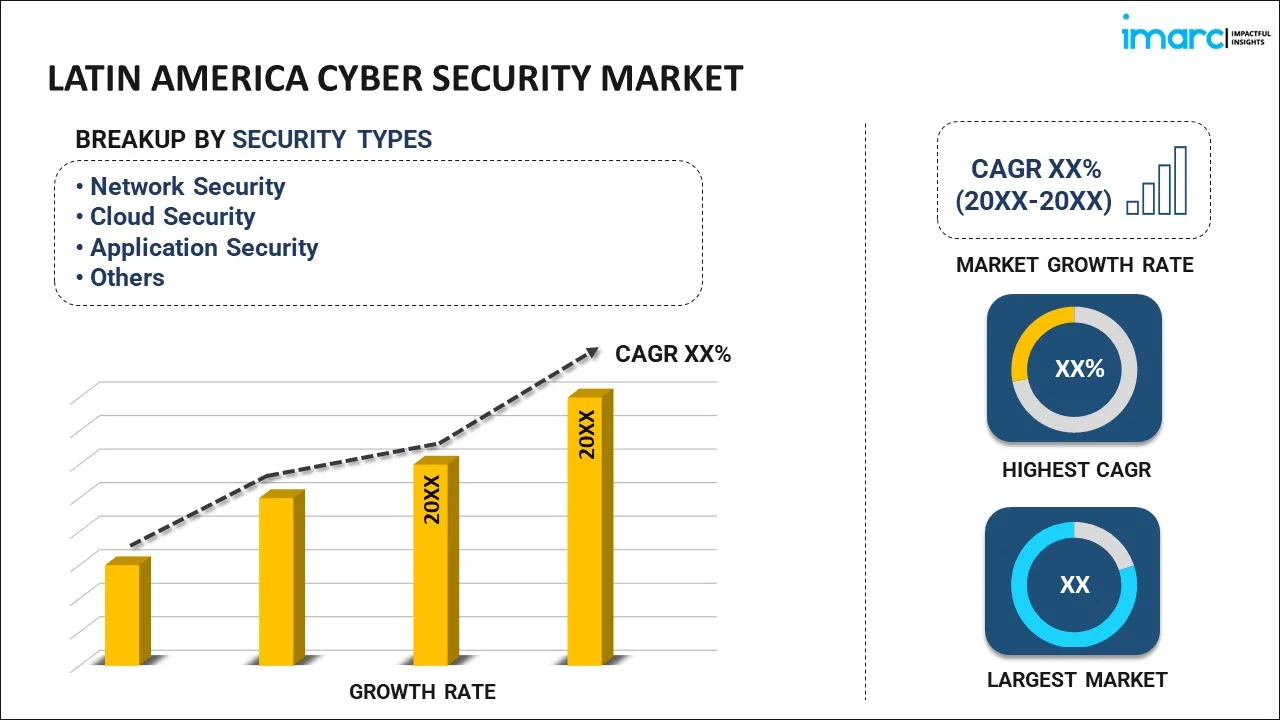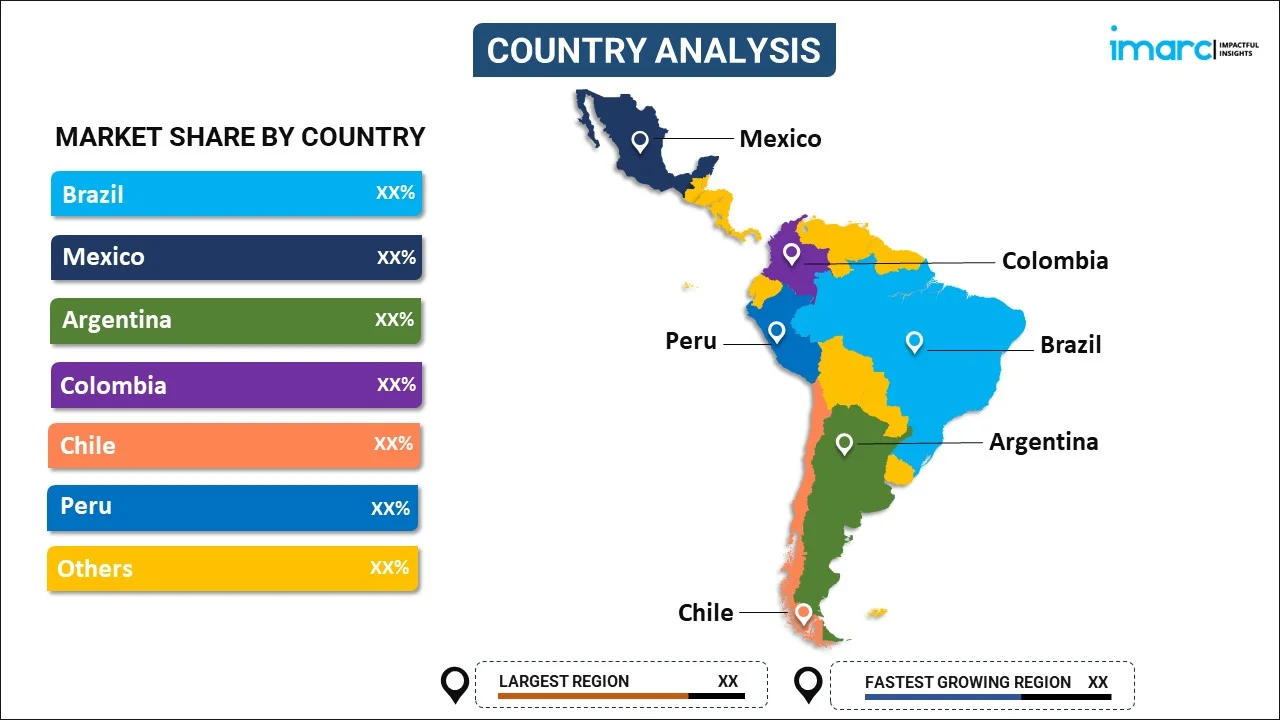
Latin America Cyber Security Market Report by Security Type (Network Security, Cloud Security, Application Security, End-Point Security, Wireless Network Security, and Others), Component (Hardware, Solution), Deployment (Cloud-based, On-premise), End User (Banking, Financial Services, and Insurance, Healthcare, Manufacturing, Retail, Government, IT and Telecommunication, and Others), and Country 2024-2032
Latin America Cyber Security Market:
Latin America cyber security market size is projected to exhibit a growth rate (CAGR) of 7.30% during 2024-2032. The increasing reliance on digital technologies is bolstering the market.
|
Report Attribute
|
Key Statistics
|
|---|---|
|
Base Year
|
2023 |
|
Forecast Years
|
2024-2032
|
|
Historical Years
|
2018-2023
|
| Market Growth Rate (2024-2032) | 7.30% |
Latin America Cyber Security Market Analysis:
- Major Market Drivers: The rising popularity of remote work models is propelling the market. Additionally, the inflating need for safeguarding interconnected systems is also positively impacting the market.
- Key Market Trends: Stringent data protection regulations are augmenting the regional market. Besides this, they adopt comprehensive security protocols, thereby stimulating the market.
- Competitive Landscape: The report has provided a comprehensive analysis of the competitive landscape in the market. Also, detailed profiles of all major companies have been provided.
- Geographical Trends: The elevating awareness among enterprises about reputational and financial risks is catalyzing the market in Brazil. Furthermore, evolving technological landscapes are also propelling the market across Mexico. Apart from this, the growing cyber threats are expanding the market in Argentina. Additionally, the rising levels of urbanization are also fueling the market in Colombia.
- Challenges and Opportunities: Inadequate infrastructure is hindering the market. However, fostering regional cooperation will continue to fuel the market over the forecasted period.
Latin America Cyber Security Market Trends:
Widespread Emphasis on Privacy Regulations
Latin American countries are strengthening privacy and data protection regulations to safeguard sensitive information. Moreover, the rising focus on protecting personal data is further prompting businesses to enhance their cybersecurity infrastructure, as failure to comply with regulations can lead to severe reputational damage. In February 2024, Latin America and the Caribbean (LAC) and the European Union (EU) set up a corporation on cybersecurity, which provides a strong foundation to strengthen their close bi-regional partnership.
Increasing Use of Cloud Security
The shifting preferences of businesses to cloud infrastructures are expanding the market. Apart from this, with the rise of digital transformation and remote work, companies are moving their data and applications to the cloud, thereby raising concerns over security vulnerabilities and data breaches. In March 2024, Eviden, one of the prominent names in digital, cloud, big data, and security announced the opening of its new security operations center (SOC) in Monterrey, Mexico, to enable advanced cybersecurity services to organizations. As per the Latin America cyber security market analysis report, this is fueling the regional market.
Rising Emphasis on Identity and Access Management (IAM)
As digital transformation accelerates across Latin America, there is an increasing focus on IAM solutions to ensure secure access to systems and data. In August 2024, Assured Data Protection, a leading IT-managed services provider, expanded its operations into Latin America, thereby expanding Rubrik's presence across the region. This expansion comes via a joint venture agreement between Rubrik and Assured, aiming to provide enterprises with cyber resiliency solutions.
Latin America Cyber Security Industry Segmentation:
IMARC Group provides an analysis of the key trends in each sub-segment of the market, along with the Latin America cyber security market forecasts at the regional and country levels for 2024-2032. Our report has categorized the market based on the security type, component, deployment, and end user.
Breakup by Security Type:

- Network Security
- Cloud Security
- Application Security
- End-Point Security
- Wireless Network Security
- Others
The report has provided a detailed breakup and analysis of the market based on security type. This includes network security, cloud security, application security, end-point security, wireless network security, and others.
Network security is essential for protecting corporate networks from data breaches and unauthorized access. Application security is important for protecting web applications. End-point security plays a vital role in securing devices used by remote workers. This is escalating the Latin America cyber security market outlook.
Breakup by Component:
- Hardware
- Solution
- Threat Intelligence and Response
- Identity and Access Management
- Data Loss Prevention
- Security and Vulnerability Management
- Intrusion Prevention System
- Others
- Services
The report has provided a detailed breakup and analysis of the market based on the component. This includes hardware, solution (threat intelligence and response, identity and access management, data loss prevention, security and vulnerability management, intrusion prevention system, and others), and services.
Hardware components play a foundational role in securing network infrastructures. On the solution front, offerings are crucial for preventing data breaches. The market is seeing continuous innovation with frequent product launches, particularly in IAM, advanced threat detection, and cloud security solutions, driven by the rising complexity of cyberattacks. These new products are helping organizations across the region improve their address evolving cyber threats more effectively, thereby expanding the Latin America cyber security market share.
Breakup by Deployment:
- Cloud-based
- On-premise
The report has provided a detailed breakup and analysis of the market based on deployment. This includes cloud-based and on-premise.
Cloud-based has gained traction as businesses widely migrate to cloud infrastructures, offering flexibility, scalability, and cost-effectiveness. These solutions are particularly attractive to small and medium-sized enterprises (SMEs) looking for robust security without the requirement for hardware investments. On-premise solutions remain popular among large enterprises that require control over their security systems. This is propelling the Latin America cyber security market demand.
Breakup by End User:
- Banking, Financial Services, and Insurance
- Healthcare
- Manufacturing
- Retail
- Government
- IT and telecommunication
- Others
includes banking, financial services, and insurance, healthcare, manufacturing, retail, government, IT and telecommunication, and others.
The banking, financial services, and insurance (BFSI) sector is one of the largest consumers of cybersecurity solutions. The elevating need for protecting patient data and medical records as digitalization in healthcare services grows is also fueling the market. Manufacturing and retail industries are focusing on securing supply chains. Government institutions prioritize cybersecurity to protect national security data. The IT and telecommunication sector demands high-level security to prevent network outages. This broad range of end-user demand is catalyzing the market across Latin America.
Breakup by Country:

- Brazil
- Mexico
- Argentina
- Colombia
- Chile
- Peru
- Others
The Latin America cyber security market research report has also provided a comprehensive analysis of all the major regional markets, which include Brazil, Mexico, Argentina, Colombia, Chile, Peru, and Others.
Government initiatives like the "National Cybersecurity Strategy" are propelling the market in Brazil. Mexico follows closely, driven by its financial sector and government investment in data protection. Argentina is increasingly focusing on data protection regulations, which has pushed businesses to upgrade cybersecurity infrastructures. Colombia has been enhancing its national cyber defense with initiatives like the "Cybersecurity and Cyber Defense CONPES 3995" strategy. Chile is experiencing growth in cloud security, particularly among financial institutions, while Peru is investing in public-private partnerships to tackle escalating threats.
Competitive Landscape:
The market research report has also provided a comprehensive analysis of the competitive landscape in the market. Competitive market price analysis, such as market structure, key player positioning, top winning strategies, competitive dashboard, and company evaluation quadrant, has been covered in the report. Also, detailed profiles of all major companies have been provided.
Latin America Cyber Security Market Recent Developments:
- August 2024: Assured Data Protection, a leading IT-managed services provider, expanded its operations into Latin America to provide enterprises with cyber security resiliency solutions.
- March 2024: Eviden announced the opening of its new security operations center (SOC) in Monterrey, Mexico, to enable advanced cybersecurity services to organizations.
- February 2024: Latin America and the Caribbean (LAC) and the European Union (EU) set up a corporation on cybersecurity, which provides a strong foundation to strengthen their close bi-regional partnership.
Latin America Cyber Security Market Report:
| Report Features | Details |
|---|---|
| Base Year of the Analysis | 2023 |
| Historical Period | 2018-2023 |
| Forecast Period | 2024-2032 |
| Units | US$ Million |
| Scope of the Report | Exploration of Historical Trends and Market Outlook, Industry Catalysts and Challenges, Segment-Wise Historical and Predictive Market Assessment:
|
| Security Types Covered | Network Security, Cloud Security, Application Security, End-Point Security, Wireless Network Security, Others |
| Components Covered |
|
| Deployments Covered | Cloud-based, On-premise |
| End Users Covered | Banking, Financial Services, and Insurance, Healthcare, Manufacturing, Retail, Government, IT and Telecommunication, Others |
| Countries Covered | Brazil, Mexico, Argentina, Colombia, Chile, Peru, Others |
| Customization Scope | 10% Free Customization |
| Post-Sale Analyst Support | 10-12 Weeks |
| Delivery Format | PDF and Excel through Email (We can also provide the editable version of the report in PPT/Word format on special request) |
Key Questions Answered in This Report:
- How has the Latin America cyber security market performed so far, and how will it perform in the coming years?
- What has been the impact of COVID-19 on the Latin America cyber security market growth?
- What is the breakup of the Latin America cyber security market on the basis of security type?
- What is the breakup of the Latin America cyber security market on the basis of component?
- What is the breakup of the Latin America cyber security market on the basis of deployment?
- What is the breakup of the Latin America cyber security market on the basis of End User?
- What are the various stages in the value chain of the Latin America cyber security market?
- What are the key driving factors and challenges in Latin America cyber security?
- What is the structure of the Latin America cyber security market, and who are the key players?
- What is the degree of competition in the Latin America cyber security market?
Key Benefits for Stakeholders:
- IMARC’s industry report offers a comprehensive quantitative analysis of various market segments, historical and current market trends, market forecasts, and dynamics of the Latin America cyber security market from 2018-2032.
- The research report provides the latest information on the market drivers, challenges, and opportunities in the Latin America cyber security market.
- The study maps the leading, as well as the fastest-growing, markets. It further enables stakeholders to identify the key country-level markets within the region.
- Porter's five forces analysis assists stakeholders in assessing the impact of new entrants, competitive rivalry, supplier power, buyer power, and the threat of substitution. It helps stakeholders to analyze the level of competition within the Latin America cyber security industry and its attractiveness.
- The competitive landscape allows stakeholders to understand their competitive environment and provides insight into the current positions of key players in the market.
Need more help?
- Speak to our experienced analysts for insights on the current market scenarios.
- Include additional segments and countries to customize the report as per your requirement.
- Gain an unparalleled competitive advantage in your domain by understanding how to utilize the report and positively impacting your operations and revenue.
- For further assistance, please connect with our analysts.
 Inquire Before Buying
Inquire Before Buying
 Speak to an Analyst
Speak to an Analyst
 Request Brochure
Request Brochure
 Request Customization
Request Customization




.webp)




.webp)












